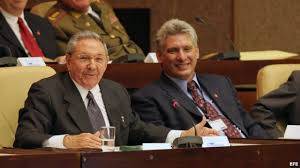Cuba is poised for the end of an era today as President Raul Castro steps down, formally handing power to his long-time deputy Miguel Diaz-Canel Bermudez — and thereby ending his family's decades-long grip on the island since the 1959 revolution.

President Raul Castro (left) with Miguel Diaz-Canel Bermudez
Between them, father of the nation Fidel and his younger brother Raul made the Caribbean island a key player in the Cold War and helped keep communism afloat despite the collapse of the Soviet Union.
The silver-haired Diaz-Canel, 57 — a top Communist Party figure who has served as first vice president since 2013 — will become the island's first leader born after the 1959 revolution, and the first in 60 years who is not named Castro.
Raul Castro, 86, is due to step down today after 10 years in office. He announced his departure several years ago and has long signalled that Diaz-Canel, a 57-year-old Communist Party stalwart, was his likely successor, carefully managing the transition to ensure political continuity.
Raul has been in power since 2006, when he took over after illness sidelined Fidel, who seized power in the revolution.
Diaz-Canel (the last name Bermudez is rarely pronounced in Spanish usage) has spent years climbing the party ranks. He was named the sole candidate for the presidency on Wednesday.
He will formally be confirmed as the country's leader at roughly 1300 GMT today — the anniversary of the 1961 Bay of Pigs invasion, when Fidel Castro's forces defeated 1,400 US-backed rebels seeking to overthrow him.
Havana has long hailed the showdown as American imperialism's first great defeat in Latin America.
It is also the day before the new president's 58th birthday.
Diaz-Canel, who some say bears a passing resemblance to American actor Richard Gere, is a fan of The Beatles whose penchant for wearing jeans has set him apart in Havana's corridors of power.
But it is believed that the move to a younger generation of Communist leaders is unlikely to herald major changes to the one-party system or state-dominated economic model, at least in the short run.
Although Diaz-Canel has advocated fewer restrictions on the press and a greater openness to the internet, he also has a ruthless streak, with harsh words for Cuba's dissidents and the United States.
Crucially, he will remain under the watchful eye of Castro, who will continue to serve as the head of Cuba's all-powerful Communist Party.
Once sworn in, Diaz-Canel will be tasked with pursuing reforms begun by Castro to open up Cuba's economy to small private entrepreneurs and reach a rapprochement with its Cold War arch-enemy, the United States.
In 2015, Havana and Washington renewed diplomatic ties, with then-president Barack Obama making a historic visit to the island a year later.
But steps towards a normalisation of ties have been severely curtailed since Donald Trump arrived in the White House last year.
Diaz-Canel will also inherit a youthful population hungry for change on the Caribbean island.
But Reuters reports that the transition was met with indifference by ordinary Cubans on the streets of Havana, with some saying they felt distant from politics and were more concerned with making ends meet within the limited economic opportunities that opened under Castro’s changes.
Cuba watchers and domestic analysts say the new president will favour continuity over change in the early days of his presidency.
As they began their momentous two-day meeting on Wednesday, the 605 delegates of the National Assembly cast their votes for the new Council of State, which counts 31 members and whose head automatically becomes president.
"I have the honourable mission of putting forward comrade Miguel Mario Diaz-Canel Bermudez as president of the Council of State," commission president Gisela Duarte told assembly delegates, effectively ending any suspense over the identity of Cuba's new leader.
Delegates immediately broke into applause and the two men rose to share an embrace as Cuba's two other vice presidents, both veterans of the revolution, looked on from the row behind.























